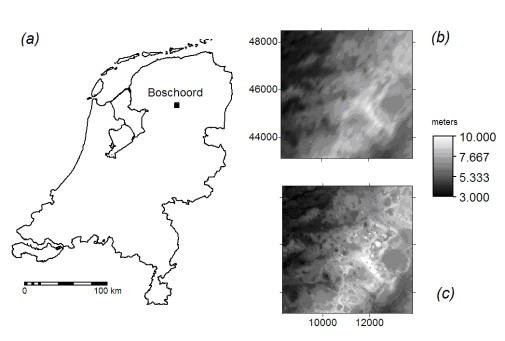Published: Oct 20, 2009 by Tom Hengl
The case study “Boschoord” (3024 ha) is a small area located in the province of Drenthe, in the northern part of the Netherlands. The Boschoord area is part of the Drenthe Plateau which is underlain by boulder clay deposited by the second last (Saalien) ice sheet. This rather complex genesis created a fragmented landscape in which hydrological differences are strongly linked to this polycyclic landscape development. What makes this dataset especially interesting is that it is an area of low relief, but with distinct geomorphological classes that have been mapped with relatively high accuracy (Koomen and Maas, 2004). The elevations range from 3 to 10 m above the sea level, with a standard deviation of 1.54 m; changes in topography are difficult to notice even in the field. This data set is available only for collaborators. To receive a password to use the data, please contact the authors.

Fig: Location of the study area (a) and the two main DEM data sources used for analysis: DEM25TOPO – generated using ordinary kriging (b) and DEM25LIDAR (c).
Available layers:
- Elevation datasets – This includes the 5 m LiDAR DEM (surveyed in 2004), and a point dataset with 5010 measurements of heights (surveyed in 1960-69). Both datasets show elevations measured with a high precision (±10-20 cm).
- Geomorphological map (GKN50) – The map contains of 12 classes: Ground moraine (3L1), Low plains with ridges (3N3), Peat bog depressions (2R4), Cover sand undulated (3L5), Low plains/depressions without ridges (3N4), Low dunes + plains (3L8), Low plains/depressions without ridges (3N4), Cover sand undulated (3K14), Undulating ground moraines (3L1), Ground moraine (high) (3L2a), Low dunes + plains (3L9), Areas partially covered with cover sand (2M14), Low dunes (4K19), and Cover sand areas (2M13).
- Topographic data – Includes all roads and infrastructure, land use classes and similar features from the TOP10VECTOR basic topographic map of the Netherlands (1:5000 scale). This data is used only for orientation purposes.Grid definition:
ncols: 1110
nrows: 1081
xllcorner: 208297
yllcorner: 543057
cellsize: 5proj4:+proj=sterea +lat_0=52.15616055555555 +lon_0=5.38763888888889 +k=0.999908 +x_0=155000 +y_0=463000 +ellps=bessel +towgs84=565.237,50.0087,465.658,-0.406857,0.350733,-1.87035,4.0812 +units=m +no_defsLineage:
The 5020 field measurements of elevation (land survey) collected in the 1960s by the ‘Meetkundige Dienst Rijkswaterstaat’. This was used to generate the 25 m DEM25TOPO. The 5 m LiDAR-based DEM distributed by the Ministry of transportation and water management (measurements in cm). This dataset is also known as “Actueel Hoogtebestand Nederland” (AHN ) (van Heerd et al. 2008).
Data owner:Universiteit van Amsterdam
Reference:Semi-automated identification and extraction of geomorphological features using digital elevation data
Location: Boschoord
Netherlands52° 53’ 55.7772” N,6° 13’ 41.2896” E
See map:Google Maps
